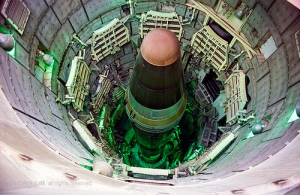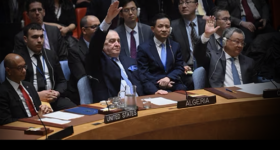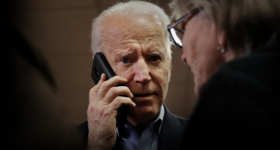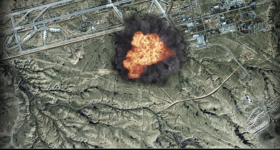By Andrew McKillop
21st Century Wire
February 26, 2011
Top and bottom, or truth and beauty quarks interest nuclear physicists, but the mutually assured destruction of both the top and bottom, namely- both the North and South parts of the global economy. It came very close indeed, programmed and running to schedule right until the end of December 2010.
Using the lever of nuclear power and the ‘creative’ financial assets generated around them, the intended mechanism featured a massive finance bubble driven by a construction spree of new, industry standard, Chernobyl-sized (900 MW and over) reactors right across the Southern emerging and developing countries, scheduled to take place between 2010-2020.

M.A.D. aka ‘MUTUALLY ASSURED DESTRUCTION’- Formerly the stuff of Cold War games, later becoming playground rules for Wall Street and City speculators.
The lynchpin target for this so-called “Nuclear Renaissance” was the entire Middle East and North African region– the Arab world, including outlier countries such as Sudan and the Central Asian muslim republics. As late as mid-year 2007, France’s President Sarkozy could crow about French success in selling its nuclear power to his respected, or at least petrodollar-flush fellow head of state, received with pomp and circumstance at the Elysee Palace(with tent and gorilla bodyguard)… Mr Muammar Gaddafi.
INFLATING THE BUBBLE
The nuclear bubble plan originated inside a small, shadowy core group of global finance and geopolitical players. The earliest coming out the so-called plan to build more nuclear reactors through 2010-2020 than in any previous period in history, took place at the UN’s Copenhagen Climate Summit in December 2009.
Upon exposure, the first plan experienced its first defeat. Even as vaguely sketched out, or alluded to by the four heads of state of leading nuclear suppliers- Obama, Merkel, Sarkozy and Brown (succeeded later by Cameron), it was promptly met with disbelief and outright hostility by leaders of China, Russia, India, Brazil and others.
Bruised but undeterred by this first failure to sell the scam, its pilot group continued its work through 2010. Their members included the likes of George Soros and his foundation, the World Shift Network, including pro-nuclear activists like Al Gore, nuclear boomers coordinated by the WNA (World Nuclear Association) and by a string of finance industry and institutional players led by the IMF, World Bank, the US Ex-IM Bank, as well as some notable major Ponzi scheme finance operators like Goldman Sachs Co. and its finance industry allies. They were frequently joined by the other three heads of government of the top 7 core nuclear industry supplier countries. Together they comprise the present 46-nation NSG-Nuclear Suppliers Group, hatched in 1974.
UNDERSTANDING THE NUCLEAR BUBBLE
Understanding why the attempt at floating a massive nuclear finance bubble – one which is approximately 10 to 50 times the size of the US sub-prime housing bubble – was doomed to either economic failure, or financial failure, or government debt and monetary failure- or all three, one only needs a flashback to the nuclear industry’s first finance bubble and meltdown, the period around 1974-1979. But at least as important, we have to add another cause of near-certain failure, along with the potential menace of massive loss of life, almost open-ended economic loss, and the ensuing environment damage.
Until the Arab youth revolt started sweeping the entire Middle East and North Africa (MENA) region in January 2011, the key geographic region for selling nuclear reactors and creating the new “Nuclear South” – was MENA.
One may ask the question: who in their right mind, 6 weeks later at end-February 2011, would suggest it is still a nice, progressive and productive, secure and useful idea to sell industry standard, Chernobyl-sized nuclear power plants to countries like Libya, Egypt, Algeria, Morocco, Jordan, Syria,Saudi Arabia, Kuwait, UAE, Iran, the Central Asian republics, or any other civil war-prone country of the region, like Sudan ?
At this moment in time any fast forward scenarios for the MENA region remain cloudy, but above all, they are troubled. Today, few could tell you the sell-by-date for remaining regimes in place in these countries.

California’s Diablo Canyon nuclear power plant completed in 1973, but earthquake fears delayed online deployment until 1981.
Apart from minor details like nuclear power plants being likely early collateral damage in civil wars of the region with massive destructive potential, the collapse of friendly dictators in the region heavily weakens another basic need of the nuclear bubble scam – for the borrowing parties to remain in existence throughout the life of this global Ponzi scheme that was going to be operated, using nuclear assets in the South as the underlying security. Why the plan or scheme to off-load, dilute or dissolve unpayable OECD debt with this scam had to be big- and would have started big, is as simple to understand as flipping through debt and deficit statistics and forecasts for the leading economies of the OECD group. Any so-called “reserve currency” or money, whether in paper dollars, paper euros, paper yen or any others, today faces mortal threat of meltdown. The traditional central banker’s game of turning the printing press and crossing one’s fingers has been shaken to its core of confidence by the global financial and monetary meltdown- a disaster which was triggered by the US sub-prime housing scam.
NUCLEAR SUB-PRIME DWARFING THE HOUSING BUBBLE
The nuclear sub-prime bubble, we can be sure, was schemed as an operation tens of times bigger than the global housing bubble. The scheme was promoted as an “energy independence” and/or low-carbon plan for emerging and developing countries of the South, but under the table featured a huge off-load of debt from the OECD super-debt countries which could supply the necessary nuclear tech, fuel and engineering services – and above all the finance packages.
The scam would have spread its wings the encompass government debt, currency and credit default swaps, SIVs (Structured Investment Vehicles) and a string of interest rate and other derived products, only limited in size and arcane complexity by the same cynical imagination of the nimble minds who gave an unsuspecting world the US sub-prime bubble – and crash.
THE FIRST ASSET BUBBLE
In market jargon anything that goes North is growing and profitable, while going South means losing money, likely going out of business. Turning this around in geographic terms, the nuclear sub-prime scam was conceived with a Southern base, but for the world nuclear industry ‘going south’ already happened- its first asset bubble still remains as a trace memory, haunting analysts and industry advocates.
The first time the industry almost died on its feet started exactly when the NSG was first founded by the original 7 pro-nuclear OECD countries, including the 3 Western members of the UN Security Council. Between 1974-1979 the industry rode a massive upsurge in asset values with reactor costs rising almost daily as the whole nuclear supply chain from uranium mining, enrichment and fuel fabrication, through reactor building and waste handling suffered double-digit annual inflation. By 1978 US Westinghouse (now Toshiba-Westinghouse) was forced to declare force-majeure on its uranium fuel supply contracts, and then on all of its new orders, reactor building and completions.
POPULAR NUCLEAR MYTHS
Elsewhere in the NSG world, financial meltdown became a threat, followed by a reality much more dire than core meltdown– as the core business of nuclear industrial players became too hot to handle. The reason was simple. The 1973-1974 oil shock generated a wave of panic in decider mindsets right across the developed OECD North, at a time when the only users of nuclear power along with communist Russia and communist China. The atom in economic folklore became the quick fix silver bullet able to shield their oil-based economies from oil price rises, despite the fact that an average intelligence child with a two-dollar pocket calculator could show, and can show today, that nuclear power saves little oil- or indeed, no oil at all.
Uninterested by such tiring details, governments and corporate deciders stampeded into their farcical attempt at saving the economy with atomic power. Reactor orders exploded. Inflation followed, and financial meltdown naturally ensued, creating what the nuclear industry still calls its ‘nuclear winter’ – stretching from the early 1980s until the late 1990s, during which a single reactor order or completion was a hailed and rare event!
NUCLEAR SALVATION
So looking back we can see clearly that through 1974-1979 the exploding track of reactor and nuclear costs was exactly the same as what has happened through 2006-2011 to date. Selling nuclear salvation from high-priced oil to know-nothing heads of state, was then, and still remains today, an easy task in the run up to, and after-glow from the recent all-time high barrel price for oil (US $ 147 on the US NYMEX in 2008). This, we can note, was likely goosed by Goldman Sachs Co.
The record price peak also included a 15-20 dollars special GS Co. premium specifically designed to bankrupt its client and victim, Semgroup Holdings, which was advised to bet, and lent funds to bet on falling oil prices… by Goldman Sachs.
READY, STEADY… OOPS
Primed and ready for the second nuclear asset bubble – this time a super-production – the world finance industry teamed with a mix and match of new-time, and old-time nuclear boomers through the years 2006-2009. This new Atomic Rat Pack ranges from the loony fringe of global warming hysterics like Jim Lovelock, James Hansen and Al Gore, to Whole Earth Catalog changeling and businessman Stewart Brand, completing his coming-out by discovering he’d always loved nuclear power all along but had been too shy to say it.
More important for the hard-sell in the South, heads of state of the 7 key NSG countries, Sarkozy and Merkel, soon joined by Obama and Brown, fell over themselves to sell the atom to literally any country at all– in Sarkozy’s case to his friend and highly respected head of state Muammar Gaddafi back in 2007. The list of nuclear-possible or likely countries in the South at end 2010 makes a lurid read. In all cases the projects include (or included, as of end 2010, the probable end of this scam) big or very big civil reactor orders, for industry standard 900MW and larger power reactors.
Apart from the MENA and the Muslim world, we find a bizarre array of crumbling dictatorships, one party states tricked out as democracies, and banana-or-oil republics, such as: Nigeria, Ghana, Bangladesh, Mongolia, Belarus,Pakistan and Indonesia. Through year 2010, in a flurry of mostly closed-door meetings, the nuclear industry boomers headed by the WNA and leading lights in the world finance industry honed down their strategy for building and launching the ultimate asset bubble.
The reason for Southern tilt was not only the lack of debt and sometimes current account surpluses in these countries, but simple facts of life in the North. In the North, environment militants, knowledge and fear of nuclear power, high costs, and the many alternatives to the atom which now include vast reserves of unconventional gas, made their sales pitch a no-go… compared with the home run in the South. In the background, this was further powered by IMF-coordinated attempts to create new mechanisms for re-indebting the emerging and developing countries, and use the South as a place to offload OECD nation debt into a massive new pool of financial paper riding the nuclear asset bubble. Also add here a rather flagging green energy asset bubble.
Perhaps the biggest reason we have to thank the cellphone-wielding Flash Mob youth of the Arab world is this: the potential for launching the new nuclear finance scam is now almost zero in the MENA region – the lynchpin for this attempt at out-doing the US sub-prime bubble. The life expectancy of such a scam today is not much more than that of a quark – about 10 to the minus 25 seconds.
COPYRIGHT ANDREW MCKILLOP 2011
—
Andrew McKillop is guest writer for 21st Century Wire. He has more than 30 years experience in the energy, economic and finance domains. Trained at London UK’s University College, he has had specially long experience of energy policy, project administration and the development and financing of alternate energy. This included his role of in-house Expert on Policy and Programming at the DG XVII-Energy of the European Commission, Director of Information of the OAPEC technology transfer subsidiary, AREC and researcher for UN agencies including the ILO.
READ MORE NUCLEAR NEWS AT: 21st Century Wire Nuclear Files
–















